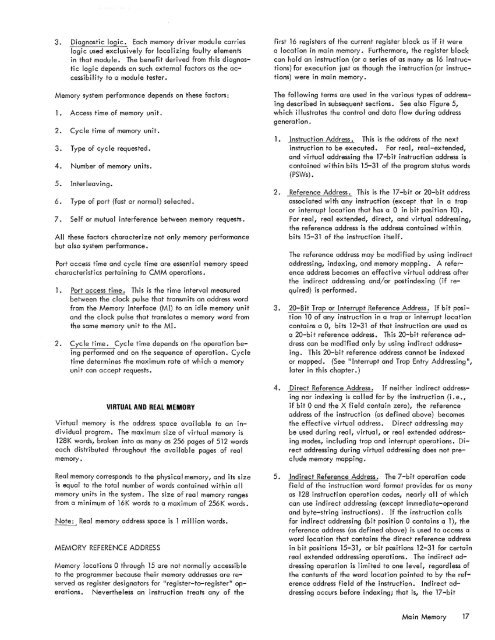1. xerox 560 computer system - The UK Mirror Service
1. xerox 560 computer system - The UK Mirror Service
1. xerox 560 computer system - The UK Mirror Service
You also want an ePaper? Increase the reach of your titles
YUMPU automatically turns print PDFs into web optimized ePapers that Google loves.
3. Diagnostic logic. Each memory driver module carrieslogic used exclusively for localizing faulty elementsin that module. <strong>The</strong> benefit derived from this diagnosticlogic depends on such external factors as the accessibilityto a module tester.Memory <strong>system</strong> performance depends on these factors:<strong>1.</strong> Access time of memory unit.2. Cycle time of memory unit.3. Type of cycle requested.4. Number of memory units.5. Interleaving.6 • Type of port (fast or norma I) selected.7. Self or mutual interference between memory requests.All these factors characterize not only memory performancebut a Iso <strong>system</strong> performance.Port access time and cycle time are essential memory speedcharacteristics pertaining to CMM operations.<strong>1.</strong> Port access time. This is the time interval measuredbetween the clock pulse that transmits an address wordfrom the Memory Interface (MI) to an idle memory unitand the clock pulse that translates a memory word fromthe same memory unit to the MI.2. Cycle time. Cycle time depends on the operation beingperformed and on the sequence of operation. Cycletime determines the maximum rate at which a memoryunit can accept requests.VIRTUAL AND REAL MEMORYVirtual memory is the address space available to an individualprogram. <strong>The</strong> maximum size of virtual memory is128K words, broken into as many as 256 pages of 512 wordseach distributed throughout the available pages of realmemory.Real memory corresponds to the physical memory, and its sizeis equal to the total number of words contained within allmemory units in the <strong>system</strong>. <strong>The</strong> size of real memory rangesfrom a minimum of 16K words to a maximum of 256K words.Note: Real memory address space is 1 mi Ilion words.MEMORY REFERENCE ADDRESSMemory locations 0 through 15 are not normally accessibleto the programmer because their memory addresses are reservedas register designators for "register-te-register" operations.Nevertheless an instruction treats any of thefirst 16 registers of the current register block as if it werea location in main memory. Furthermore, the register blockcan hold an instruction (or a series of as many as 16 instructions)for execution just as though the instruction (or instructions)were in main memory.<strong>The</strong> following terms are used in the various types of addressingdescribed in subsequent sections. See also Figure 5,which illustrates the control and data flow during addressgeneration.<strong>1.</strong> Instruction Address. This is the address of the nextinstruction to be executed. For real, real-extended,and virtual addressing the 17-bit instruction address iscontained within bits 15-31 of the program status words(PSWs) •2. Reference Address. Th is is the 17 -b i t or 20-b it addressassociated with any instruction (except that in a trapor interrupt location that has a 0 in bit position 10).For real, real extended, direct, and virtual addressing,the reference address is the address contained withinbits 15-31 of the instruction itself.<strong>The</strong> reference address may be modified by using indirectaddressing, indexing, and memory mapping. A referenceaddress becomes an effective virtual address afterthe indirect addressing and/or postindexing (if required)is performed.3. 20-Bit Trap or Interrupt Reference Address. If bit position10 of any instruction in a trap or interrupt locationcontains a 0, bits 12-31 of that instruction are used asa 20-b it reference address. Th is 20-b i t reference addresscan be modified only by using indirect addressing.This 20-bit reference address cannot be indexedor mapped. (See "Interrupt and Trap Entry Addressing",later in this chapter.)4. Direct Reference Address. If neither indirect addressingnor indexing is called for by the instruction (i. e.,if bit 0 and the X field contain zero), the referenceaddress of the instruction (as defined above) becomesthe effective virtual address. Direct addressing maybe used during real, virtual, or real extended addressingmodes, including trap and interrupt operations. Directaddressing during virtual addressing does not precludememory mapping.5. Indirect Reference Address. <strong>The</strong> 7-bit operation codefield of the instruction word format provides for as manyas 128 instruction operation codes, nearly all of whichcan use indirect addressing (except immediate-operandand byte-string instructions). If the instruction callsfor indirect addressing (bit position 0 contains a 1), thereference address (as defined above) is used to access aword location that contains the direct reference addressin bit positions 15-31, or bit positions 12-31 for certainreal extended addressing operations. <strong>The</strong> indirect addressingoperation is limited to one level, regardless ofthe contents of the word location pointed to by the referenceaddress field of the instruction. Indirect addressingoccurs before indexing; that is, the 17-bitMain Memory 17
















